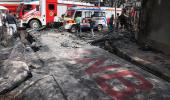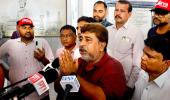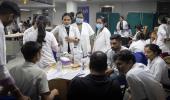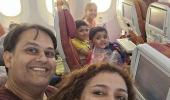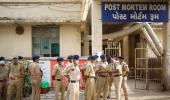'If you have 270 bodies and each body is fragmented into 10 parts, you cannot do (so many) DNA tests and even if you do it will be a long procedure.'

The crash of AI 171 at Ahmedabad took away 270 lives.
Funeral formalities are yet to be completed for most of the fatalities, as relatives agonisingly wait for the DNA identification process to be done and to finally receive the right package of last remains of a father, mother, sibling, partner/spouse or child.
Already the DNA testing of 119 victims is over.
How long will it take for the others to be concluded? What does the procedure involve? Will vestiges of all the dead be eventually found?
Identification of victim remnants of awful tragedies has often been an honorous task Dr Rajesh Chandrakant Dere takes on, as part of his job as a senior forensic expert.
Professor and head of forensic medicine and toxicology at the Topiwala National Medical College and attached B Y L Nair Hospital, central Mumbai, Dr Dere was called in for his expertise during Mumbai's 26/11 terror attacks for help in categorising victims and for testifying as a medicolegal expert in the trial that ensued.
He also assisted in detecting and classifying the bodies in the 2017 Elphinstone Bridge stampede tragedy and the Kamala Mills fire in 2017. He provides Vaihayasi Pande Daniel/Rediff with some answers:
What is the DNA identification procedure for the victims of the AI 171 crash?
In such a mass disaster, bodies may be partly mutilated, completely mutilated or fragmented also.
They first collect all the mutilated fragments, tissues, bones. Based on the anatomical morphology and an approximation (by a practiced professional eye), they group the fragments.
You cannot do DNA testing of every fragment -- it is practically impossible -- so the second part of the procedure is to tag, by some code number, a group of clones or fragments, assembled based on anatomical configuration.
Now in this crash, the bodies were fragmented. You are not going to get an intact body. Or for few only you may get. But you may get a body with a hand missing, another with the head missing or a body with the cranial vault missing.
You have to reconnect all these bones or fragments and regroup them. If a hand is available from the scene, then it has to be kept with its matching body and so on.
Finally, you have to collect DNA of each and every body. After you segregate the bodies and classify the parts of the body, you do the DNA of each (assemblage of) body parts.
If you have 270 bodies and each body is fragmented into 10 parts, you cannot do (so many) DNA tests and even if you do it will be a long procedure.
There are so many bodies, all burnt and they are all mixed together?
Yes. You have to group based on anatomical considerations and then do the testing.
Once you group it, what is the next step?
Once 270 groups of related body parts are made, each has to be tagged with an identification number. Then you have to collect DNA from each body (collection of body parts). 270 DNA collections have to be done. But they need to only collect bones and teeth because they are the last parts of a body to get burnt.
There is a list of missing people and a list of onboard flight members. A blood relative for each and every of those bodies that could not be identified, has to be called.
Say a body is fragmented and the facial configuration is not intact and it's beyond identification, a blood relative, a mother, father, son and daughter will be called.
We have the names, because during boarding we got the names and addresses of each passenger. In the medical college also, all those who died we have the names.
Blood samples have to be collected from all these blood relatives/biological descendants.
270 blood samples would have been collected. And there are now 270 DNA profiles of the deceased (or less) of those who could not be identified from the bodies.
Then the DNA profiling will have to be done in the DNA lab of all the blood samples as well as of the parts of the dead bodies that could not be identified on external examination. Both these groups will be matched. This is done by software. It automatically matches the DNA of the dead body components with the live blood donors.
Feature Presentation: Ashish Narsale/Rediff
